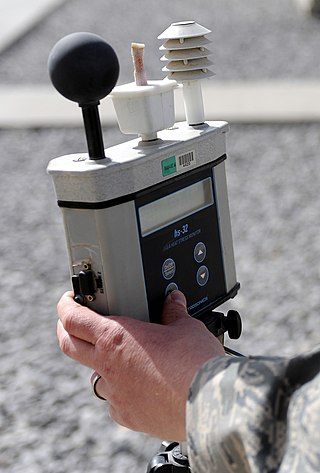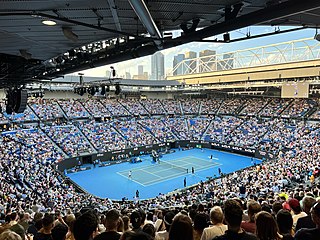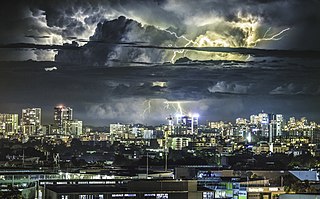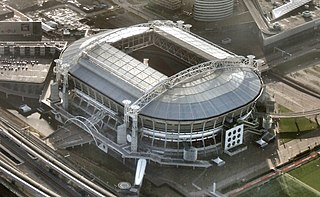
The Australian Open is a tennis tournament organized by Tennis Australia annually at Melbourne Park in Melbourne, Victoria, Australia. It is chronologically the first of the four Grand Slam tennis events every year, held before the French Open, Wimbledon and the US Open.

Rodney George Laver is an Australian former tennis player. Laver was ranked the world number 1 professional player indisputably for five years from 1965 to 1969 and by some sources also in 1964 and 1970. He was also ranked as the number 1 amateur in 1961 and 1962. Laver won 198 singles titles which is the most won by a player in history.

Melbourne Park is a sports venue in the Melbourne Sports and Entertainment Precinct in Melbourne, Victoria, Australia. Since 1988, Australia's bicentenary, Melbourne Park has been home of the Australian Open Grand Slam tennis tournament played annually in January. The park has multiple venues where the Australian Open matches take place. Rod Laver Arena is the largest venue with a capacity of 15,000, while John Cain Arena seats 10,500 and Margaret Court Arena 7,500. The three venues feature retractable roofs, allowing events to be played indoors or outdoors. Besides, there is the Show Court 3 and 1573 Arena which both have a 3,000 seating capacity, and the new 5000-seat Kia Arena. In total there are 35 outdoor Greenset tennis courts at Melbourne Park.

The wet-bulb globe temperature (WBGT) is a measure of environmental heat as it affects humans. Unlike a simple temperature measurement, WBGT accounts for all four major environmental heat factors: air temperature, humidity, radiant heat, and air movement. It is used by industrial hygienists, athletes, sporting events and the military to determine appropriate exposure levels to high temperatures.

Rod Laver Arena is a multipurpose arena located within Melbourne Park, in Melbourne, Victoria, Australia. The arena is the main venue for the Australian Open, the first Grand Slam tennis tournament of the calendar year.

Adelaide, the capital city of South Australia, has a Mediterranean climate, with mild wet winters and hot dry summers.

The wet-bulb temperature (WBT) is the temperature read by a thermometer covered in cloth which has been soaked in water at ambient temperature and over which air is passed. At 100% relative humidity, the wet-bulb temperature is equal to the air temperature ; at lower humidity the wet-bulb temperature is lower than dry-bulb temperature because of evaporative cooling.

Apparent temperature, also known as "feels like", is the temperature equivalent perceived by humans, caused by the combined effects of air temperature, relative humidity and wind speed. The measure is most commonly applied to the perceived outdoor temperature. Apparent temperature was invented by Robert Steadman who published a paper about it in 1984. However, it also applies to indoor temperatures, especially saunas, and when houses and workplaces are not sufficiently heated or cooled.
The 2007 Australian Open was a Grand Slam tennis tournament held in Melbourne, Australia from 15 January until 28 January 2007.

The climate of Sydney, Australia is humid subtropical, shifting from mild and cool in winter to warm and occasionally hot in the summer, with no extreme seasonal differences as the weather is moderated by proximity to the ocean, although more contrasting temperatures are recorded in the inland western suburbs. Despite the fact that there is no distinct dry or wet season, rainfall peaks during summer and autumn months, and is at its lowest just around the middle of the year, though precipitation can be erratic throughout the year. Precipitation varies across the region, with areas adjacent to the coast being the wettest. According to the Bureau of Meteorology, Sydney falls in the temperate climate zone which has warm to hot summers and no dry season. Sydney's plant hardiness zone ranges from zone 11a to 9b throughout the metropolitan area. Under the Holdridge Life Zones classification, eastern Sydney falls in the Subtropical Moist Forest zone and the western suburbs in the Subtropical Dry Forest zone.
Serena Williams defeated Maria Sharapova in the final, 6–1, 6–2 to win the women's singles tennis title at the 2007 Australian Open. It was her third Australian Open singles title and her eighth major singles title overall. Ranked as the world No. 81, she became the first unseeded player to win the title since Christine O'Neil in 1978.

A retractable roof is a roof system designed to roll back the roof of a structure so that the interior of the facility is open to the outdoors. Retractable roofs are sometimes referred to as operable roofs or retractable skylights. The term operable skylight, while quite similar, refers to a skylight that opens on a hinge, rather than on a track.
The 2008 Australian Open was a tennis tournament played on outdoor hard courts. It was the 96th edition of the Australian Open, and the first Grand Slam event of the year. It took place at the Melbourne Park in Melbourne, Australia, from 14 through 27 January 2008.

The 2009 Australian Open was a tennis tournament played on outdoor hard courts. It was the 97th edition of the Australian Open, and the first Grand Slam event of the year. It took place at the Melbourne Park in Melbourne, Australia, from 19 January through 1 February 2009. The tournament is remembered for containing many notable matches of the 2009 year, including the Nadal v Verdasco semi final and the Nadal v Federer final. It was the first hard court Grand Slam in which Nadal made the final or won.

The 2009 southeastern Australia heat wave was a heat wave that commenced in late January and led to record-breaking prolonged high temperatures in the region. The heat wave is considered one of the, if not the, most extreme in the region's history. During the heat wave, fifty separate locations set various records for consecutive, highest daytime and overnight temperatures. The highest temperature recorded during the heat wave was 48.8 °C (119.8 °F) in Hopetoun, Victoria, a record for the state. Many locations through the region recorded all-time high temperatures including capital cities Adelaide, which reached its third-highest temperature, 45.7 °C (114.3 °F), and Melbourne, which recorded its highest-ever temperature on record, 46.4 °C (115.5 °F). Both cities broke records for the most consecutive days over 40 °C (104 °F), while Mildura, Victoria recorded an all-time record twelve consecutive days over 43 °C (109 °F).
The 2016 Australian Open was a tennis tournament that took place at Melbourne Park between 18 and 31 January 2016. It was the 104th edition of the Australian Open, and the first Grand Slam tournament of the year. The tournament consisted of events for professional players in singles, doubles and mixed doubles play. Junior and wheelchair players competed in singles and doubles tournaments.
The 2019 Australian Open was a Grand Slam tennis tournament that took place at Melbourne Park from 14 to 27 January 2019. It was the 107th edition of the Australian Open, the 51st in the Open Era, and the first Grand Slam of the year. The tournament consisted of events for professional players in singles, doubles and mixed doubles. Junior and wheelchair players competed in singles and doubles tournaments. The 2019 Australian Open was the first Australian Open to feature final set tie-breaks.

Show Court Arena, also known by naming rights sponsorship as Kia Arena, is an open-air tennis stadium located in Melbourne Park in Melbourne, Victoria, Australia. The arena opened in advance of the 2022 Australian Open. It seats 5,000 spectators and is the fourth-largest tennis venue at Melbourne Park.

Ollie Jay is an Australian-Welsh academic based at the University of Sydney who is a researcher into exercise and working in hot conditions.














